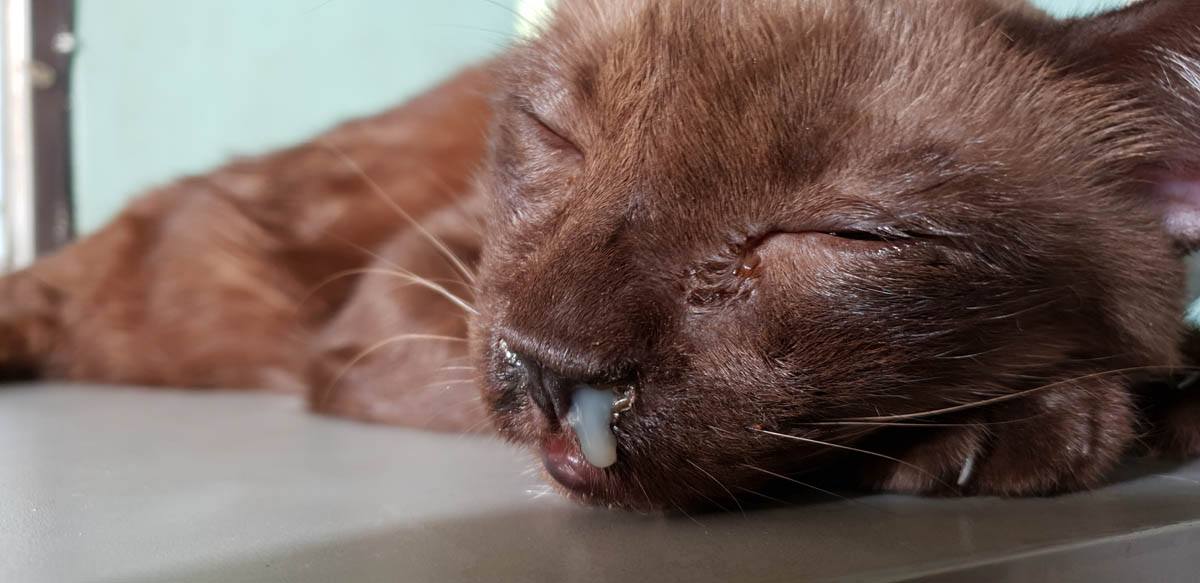Nasal congestion is a manifestation of nasal inflammation (medically termed rhinitis) which leads to excess mucus. The type of discharge will vary depending on the underlying cause but may be watery, mucoid (thick), purulent or bloody. Discharge can lead to congestion in which the nose becomes partially or fully blocked. This affects the cat’s ability to smell, which can impact the cat’s appetite.
Causes
The most common cause of nasal congestion is cat flu (usually caused by feline herpesvirus or calicivirus), which is similar to a human cold. Other causes include allergies, foreign body, fungal infections, nasal polyps, neoplasia, gum disease, tooth root abscess and cleft palate.
Nasal congestion can affect one or both nasal passages and can be chronic (long-standing) or acute. The type of discharge, along with presenting symptoms may give the veterinarian a clue as to the underlying cause.
How to treat a congested cat
The goal of treatment is to address the underlying cause as well as relieve congestion. Unfortunately, most of the medications we take to resolve nasal congestion are toxic to cats.
Increase humidity
Place the cat in a small room with doors and windows closed, use a cool-mist humidifier twice a day. Humidity helps to break up mucus and soothe inflamed nasal passageways loosen up congestion within the nasal passages.
If you don’t have a humidifier, place the cat in a warm bathroom with the shower running for 10-15 minutes. The water should be hot enough to fill the bathroom with steam, which moistens the mucus and helps it drain from the nasal cavity.
Do this two to three times a day.
Saline nose drops
Saline nose drops can be purchased over the counter at any chemist (pharmacy), always check the label to make sure it only contains saline and no other medications which can be toxic to cats.
These drops are designed for human nostrils which are considerably larger than a cat’s nostrils. Take care when instilling saline nose drops to not introduce too much saline into the nostril. You can add a drop or two to the end of a cotton bud and squeeze the liquid into the nostril.
Saline usually causes the cat to sneeze which can help to clear the nasal passages.
Remove eye and nasal discharge
Discharge from the eyes and nose can dry and form crusts. Dip a facecloth or cotton balls in warm water and apply to the crusty area to soften, and wipe away. Do not add anything to the facecloth, just water. Be careful when wiping the cat’s eyes and nasal area as it can be sore.
Encourage the cat to eat
Just as we often lose our appetite when we have a cold, cats can too when they can’t smell anything due to congestion. A cat must eat so that he or she has enough energy to get better.
Offer high-value food such as chicken breast, tinned tuna or baby food (make sure it doesn’t contain garlic or onion), and warm in the microwave to make the food smell more pungent. Stir well to ensure there are no hot spots. Soft food has the added benefit that it is more gentle on the throat which may be sore if the cat has an upper respiratory tract infection.
Maintain hydration
Cats can dehydrate quickly when they are sick, particularly if they are not eating enough. Encourage the cat to drink water by keeping a clean, fresh supply close. Switching to a canned diet or poached chicken breast with a small amount of water from the pan can increase fluid intake.
Set up a quiet and comfortable area
Keep the cat as warm and comfortable as possible. Set up a comfortable bed with food and water bowls and a litter tray. Cats who have cat flu should be kept in a separate room from other cats in the household to reduce the risk of transmission.
Medical treatment
Seek veterinary attention if home care does not work, if symptoms don’t resolve within a day or two, or if the cat is displaying additional symptoms such as refusal to eat, dehydration, fever, lethargy and weakness.
- Antibiotics to treat secondary infection
- Pediatric topical decongestants
- Anti-inflammatories
- Antihistamines (Diphenhydramine)
- Appetite stimulants
- Fluid therapy
- Nebuliser
- Oxygen therapy
Never administer over the counter or prescriptions to a cat (including human cold medication or painkillers) unless your veterinarian has instructed you to do so. Most human medications are extremely toxic to cats due to their altered metabolism.
Chronic rhinitis
Some cats with chronic rhinitis will experience flare-ups in the future. By treating nasal charge and maintaining nutrition, symptoms should quickly improve.
Keeping the cat in a stress-free home, feeding a quality and balanced diet and following a vaccine protocol outlined by your cat’s veterinarian can help to reduce flare-ups in the future.

